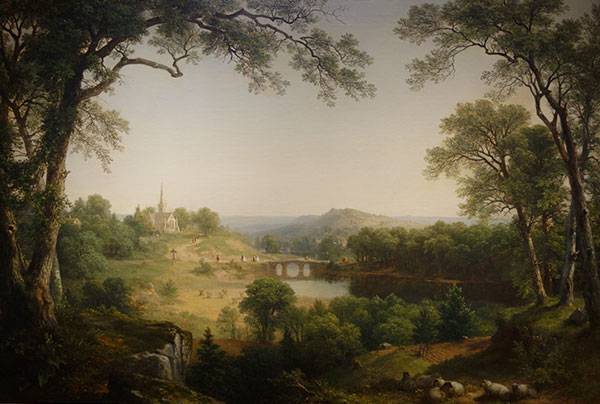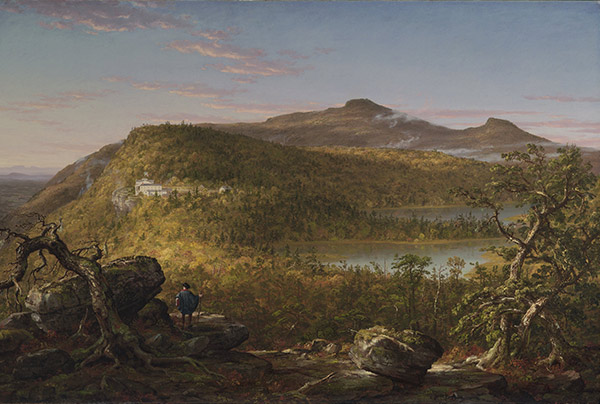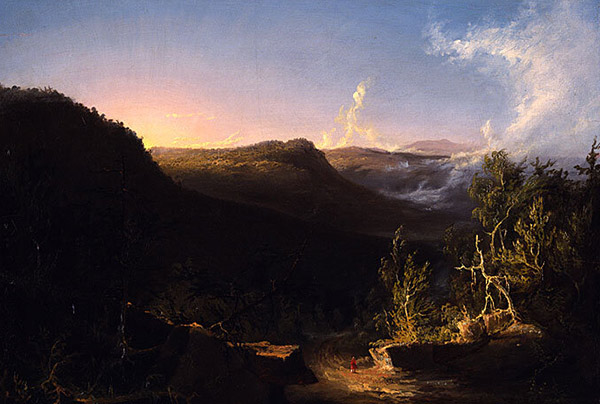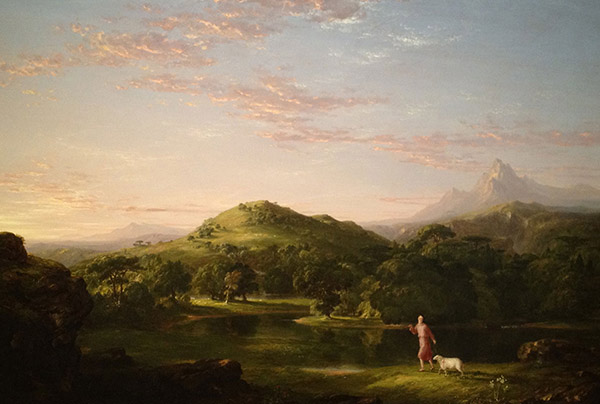Subtotal: $
Checkout
Thomas Cole’s Landscapes: Beholding and Belonging
The founder of the Hudson River School of painting believed it is possible for humanity to live well together with nature.
By Ellie DuHadway
September 8, 2022
Available languages: Español
Can a landscape painting provide its viewer with guidance on how to live well with creation?
In the past ten years, people of faith have begun to take caring for the environment more seriously. But Thomas Cole (1801–1848), a British-American Protestant landscape painter and founder of the Hudson River School, paved the way nearly two centuries years ago with insight into our relationship to creation.
Cole’s personal history affected his view of the natural world and industrialization. He grew up witnessing a radically anti-industrial movement led by a faction called the Luddites in his home of Lancashire in northwestern England. His family emigrated from England to the United States in 1818, settling first in Ohio before moving farther northeast. By the time Cole arrived in the Hudson Valley in 1825, the valley’s natural wilderness was in danger of being lost to industrialization. Local tanneries were dumping waste into the Hudson River, hemlock and bluestone were being extracted by the barge load, and high demand for wood and charcoal caused were causing mass deforestation throughout the river’s watershed. Much of Cole’s painting and writing laments American industrialization and human exploitation of the land.
Cole painted large-scale landscapes of the wilderness in all its forms in the Northeast: rolling, grassy fields, hazy blue mountains, and heavy clouds looming with the dark thrill of a wild storm over the countryside. A significant detail can be found in many of his paintings, especially those captured in the Northeastern wilderness he sought to protect: Cole included small, detailed figures beholding the grandeur of the landscape, walking through it as if on a journey, or even making a home in it. By all accounts, he was aware of humanity’s destruction of the Hudson Valley. Why, then, did he continue to include people in his landscapes as he did? Cole answers by suggesting that it is possible for humanity to live well with nature.
While landscape paintings were popular during Cole’s life, his thoughts on the relationship between humanity and nature were generally not shared by those around him. The US president of the era, Andrew Jackson, as well as many of Cole’s contemporaries believed in Manifest Destiny, a philosophy advancing westward expansion as a divine right. Furthermore, the paintings of many artists of the time celebrated the domestication of landscapes by farms, gardens, and livestock – a subtle yet definitive human takeover of land that was once wild. To illustrate, Asher Durand’s The Sunday Morning shows a landscape tamed: the sun shines on a parish church, illuminated atop a hill cleared of forest for the building. Congregants cross the river on a sturdy stone bridge; in the distance, a neighboring town is shown nestled on the riverbank. Some trees remain standing, but they have the distinct purpose of providing shelter for the livestock in the foreground.

Asher B. Durand, The Sunday Morning, 1860
While Cole himself was not as extreme an anti-industrialist as the Luddites were, his paintings and writings display a tension between convictions. He laments the idea of nature becoming completely unrecognizable through Western expansion, but he remains convinced, in spite of the pollution he witnessed, that there is still a way forward for people to live in harmony with nature.

Thomas Cole, A View of Two Lakes and the Mountain House, 1844
For example, Cole’s painting A View of the Two Lakes and the Mountain House, Catskill Mountains, Morning shows a well-dressed hiker, notebook and walking stick in hand, beholding the mountainous scenery before him. The wilderness is largely untouched as far as the eye can see, save for the Catskill Mountain House, a famous hotel built into the mountainside in 1824. A View of the Two Lakes does not romanticize a time long gone, nor does it envision an industrialized future by casting a cityscape over the wilderness. Instead, Cole shows a peaceful coexistence between the far-off Mountain House, the hiker in the forefront, and the wilderness, each seemingly unbothered by the other’s presence.
Similarly, in another work, Catskills Mountain Landscape, a traveler stands alone in the foreground of the wilderness. The surrounding world is darker and more rugged than in A View of the Two Lakes, but the traveler is unperturbed, taking a pilgrim-like walk into the landscape’s vastness. These landscapes show the viewer that it is good to remember one’s smallness and that even in smallness one still has a meaningful role of responsibility within nature. As Carl Pfluger writes, Cole “held out the hope for a harmonious coexistence of the human and the natural.”

Thomas Cole, Catskills Mountain Landscape, 1826
It seems that Cole was ahead of the curve regarding how Christians should understand and interact with the environment – as a way to connect with the divine. In “Essay on American Scenery” (1836) Cole himself wrote:
It has not been in vain – the good, the enlightened of all ages and nations, have found pleasure and consolation in the beauty of the rural earth. Prophets of old retired into the solitudes of nature to wait the inspiration of heaven. It was on Mount Horeb that Elijah witnessed the mighty wind, the earthquake, and the fire; and heard the “still small voice” – that voice is YET heard among the mountains! St. John preached in the desert; – the wilderness is YET a fitting place to speak of God.
Instead of setting up a conflict between worshiping God and worshiping nature, Cole’s inclusion of people in his landscape paintings provides Christians with a renewed vision of nature and an ethic for treating it rightly. Many of his contemporaries idealized human expansion, while today people are encouraged to stop procreating to allow nature to flourish again. The Christian worldview, however, contends for the flourishing of both land and people. The Psalmist, on encountering the beauty of the natural world, (Ps. 8:3–5) wrote:
When I look at your heavens, the work of your fingers,
the moon and the stars that you have established;
what are human beings that you are mindful of them, mortals that you care for them?
Yet you have made them a little lower than God, and crowned them with glory and honor.
The Psalmist, too, contemplates human worth in the context of the grandeur of creation, but concludes that humankind belongs “a little lower than God,” with the autonomy to create and destroy.
Cole, a devout Protestant, also painted several landscapes as religious or allegorical scenes, such as his The Voyage of Life series. Included in his more overtly religious collection is The Good Shepherd, a common subject in the canon of art history. Cole’s version of this classic painting is an atypical representation of Christ. He is a small figure in the expansive scenery. Christ walks alone in a lush valley, with the one sheep that he left ninety-nine others to find (Matt. 18:12), leading it gently along a tranquil lake. The painting harkens to the parable of the lost sheep, but it also includes imagery from Psalm 23: “The Lord is my shepherd … He makes me lie down in green pastures … He leads me beside quiet waters.” The gentle view of the landscape reflects the gentleness of Christ’s character through these two sections of scripture. The peculiar composition of The Good Shepherd also displays the humanity of Christ as he appears small within the natural world – reminding the viewer that the Son of God arrived in a gentle and lowly way, forsaking heavenly glory and choosing to live humbly in creation in human form.

Thomas Cole, The Good Shepherd, 1848
In her book Placemaker, Christie Purifoy writes, “The creation story of Genesis is unlike the creation myths of other religions because it states that we are made of the same raw material as the world around us. We are not offspring of the gods. We are made of dust. We may bear the image of a creator, but we also share kinship with stars and starfish. … Our strongest, safest houses are made of rock and clay, the same ‘dust’ of our own making.” As Cole’s works suggest, a believer’s response to the natural world is to remember that humankind, too, is dust. Our small presence in the wilderness signals our greater smallness before the divine, as Job and the Psalmist explain in scripture. There is beauty in insignificance, and, paradoxically, there is also beauty in being part of the creation that God called very good and gave to us as a gift to steward and care for, despite human potential to exploit and destroy. The life of faith is to step into a delicate balance: both the mystery of insignificance and the mystery of acceptance in the kingdom of God, just as Cole’s figures are accepted into the natural kingdom, small within its midst.
In Cole’s “Essay on American Scenery” he writes: “Nature has spread for us a rich and delightful banquet. Shall we turn from it? We are still in Eden …” Aware of the profound beauty of the world, he invites people to behold it, and remain in it – to refrain from destroying the land but to not disappear from it either. The wilderness belongs, in Cole’s vision, but humankind does too.
Humankind is no longer in Eden, as Cole claims. The world is fractured by human brokenness and self-interest. We crowd one another, physically and in other ways too. Yet Cole’s words and paintings stir a longing for the new creation, and they hold true in their admonishment. Cultivate the world and make places to live as children of God who belong here, but also care for the world by protecting and respecting wild lands and native species and by partnering in faith with Christ’s mission to one day renew the world.
Already a subscriber? Sign in
Try 3 months of unlimited access. Start your FREE TRIAL today. Cancel anytime.






